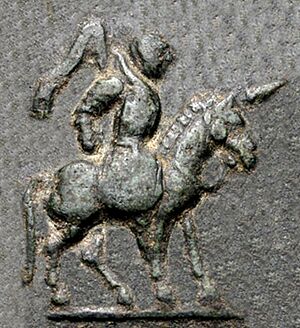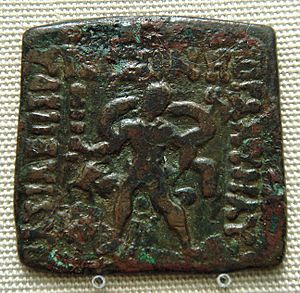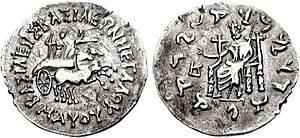Maues facts for kids
Quick facts for kids MauesΜαύης |
|
|---|---|

Maues riding in armour. Like many other Indo-Scythians, Maues did not issue portraits.
|
|
| Indo-Scythian king | |
| Reign | 98/85 – 60/57 BCE |
| Spouse | Machene |
| Religion | Greek Hinduism |
Maues was a powerful king who ruled from about 98/85 BCE to 60/57 BCE. He was the very first Indo-Scythian king.
Maues led his people, the Sakas, into India. He took control of lands that belonged to the Indo-Greek rulers. This made the Sakas very strong in the region.
Contents
Who Was King Maues?
Maues's name appears on his coins and in old writings. In the Gandhari language, his name was often Moa. In Ancient Greek, it was Maúēs.
These names come from a Scythian word. It means "tiger" or "hero." This shows how important and brave he was seen.
Another name for Maues was Moga. This name also meant "tiger" or "hero." It was found on an old copper plate from Taxila.
The Sakas: A Nomadic People
The Sakas were a group of Eastern Iranian peoples. They were nomads, meaning they moved from place to place. They were related to the Parni and Scythians.
The Sakas came from a region called Sakastan. They moved into the Indus Valley around 88 BCE. This was near the end of the reign of a Parthian king named Mithridates II.
Maues took a special title: "Great King of Kings." This was a very important title. It showed he was a powerful ruler, even more so than other kings.
Maues's Conquests and Rule
Maues is the first Saka ruler we know of in the Indus region. An old writing called the Moga inscription mentions him. It talks about "the Great King, the Great Moga."
Maues made his kingdom much bigger. He captured important cities along the Indus River. These included Taxila in Punjab and Pushkalavati. Pushkalavati was the capital city of the Gandhara region.
He took these cities from the Indo-Greek Kingdoms. Maues even made new coins by stamping over old coins of other kings. This showed his power. During his rule, the Sakas' influence reached as far as Mathura.
How Maues Arrived in India
It's not fully clear when Maues came to India. But we know the Scythian people were forced out of Central Asia. This happened because they fought with another group called the Yuezhi.
Ancient texts say the Scythians moved south. They crossed a difficult mountain pass. Inscriptions found in the Chilas/Gilgit area confirm this route. These inscriptions even have Maues's name on them.
Maues's Coins

Maues issued many coins during his reign. Some of his coins show a queen named Machene. She might have been from an Indo-Greek royal family.
Another Indo-Greek king, Artemidoros, called himself "Son of Maues" on his coins. This suggests a connection between their families.
Buddhist Symbols on Coins
Some of Maues's coins show a king sitting cross-legged. Some people think this might be one of the first images of the Gautama Buddha on a coin. However, the figure seems to hold a sword, so it might be Maues himself.
Maues also used symbols related to Buddhism on his coins. For example, he used the lion symbol. The lion was a symbol of Buddhism since the time of King Ashoka.
The Buddhist Indo-Greek king Menander II also used the lion symbol. This suggests that Maues might have supported Buddhism. He also included other religious symbols, like the bull of Shiva. This shows he allowed different religions in his kingdom.
Images for kids
| Preceded by '(In Arachosia, Gandhara and Punjab) Indo-Greek King Archebios (In Paropamisade) Indo-Greek King Hermaeus' |
Indo-Scythian Ruler (85–60 BCE) |
Succeeded by (In Gandhara) Indo-Greek king: 'Artemidoros (In Punjab) Indo-Greek king: Apollodotus II (In the south) Indo-Scythian ruler: Vonones' |



